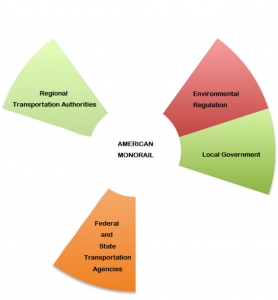 Centralized Funding and Design Criteria
Centralized Funding and Design Criteria
Funding and planning criteria governing the development of mass transportation, as well as, virtually all other forms of transportation facilities, systems and services are concentrated in the federal agencies that have been the historic source of 85-90% of all transportation development funds. The centralized, top down structure of transportation planning, funding and regulation tends to foster transportation system developments of great similarity and cost in distinctly different regions, conditions and settings across the nation. Under the stewardship of regional transportation authorities, transportation planning and project developments tend to produce variations and adaptations of subways, light rail and heavy rail passenger trains to address and meet the diverse needs of cities, urban areas and regions of the United States. Applying remarkably similar technology and configurations of steel wheeled trains on steel rail track systems to a diverse range of conditions, populations and geographic settings leads to marginal, yet costly transportation development and services that test the limits of financial and functional sustainability.
The regional transportation authorities through which federal transportation agencies fund and implement federal transportation policy exercise near monopoly authority and discretion over the design and financing of local and regional transportation development and services. Notwithstanding the extensive public review and hearings required of all transportation planning and implementation processes, local government and community interests tend to be subordinated or subsumed in the planning processes prescribed by federal authorities and environmental regulatory agencies. Plans, equipment and systems chosen for implementation through the arcane and bureaucratic procedures of regional transportation authorities tend to produce mass transportation projects and services that address problems or meet the expectations of few, if any of the communities they purportedly represent. The bureaucratic nature of regional transportation authorities and agencies, as well as, their susceptibility to political manipulation, tend to set their planning and development processes apart from the very communities and constituencies they have been empowered to serve.
Further usurping local decision making, planning prerogatives and financial control, regional transportation authorities such as the Los Angeles County Metropolitan Transportation Authority (LACMTA) have managed to invert the historic relationship between federal and local public transportation development funding from the 85%-15% federal-local mix of the past three decades, to the current 20%-80% funding regime of the MTA’s 35-year development plan and the 30/10, $8.8 billion federal loan proposal committing future LA County sales tax revenues to debt service. Shifting of tens of billions of dollars of transportation spending and debt onto local taxpayers, while preventing any meaningful participation in the decision making and planning processes that shape the transportation systems so vitally impacting respective communities, only serves to exacerbate the budget shortfalls, as well as, transportation problems of local governments and the communities they serve. The cavalier description of the 30/10 loan as “leverage” by LACMTA representatives and local elected officials, joined by select political and special interest advocates before a February 2011, Joint Congressional Transportation Committee hearing in Los Angeles, would add federally leveraged debt to already overburdened LA County taxpayers without affording an opportunity for testimony or input from affected community representatives, taxpayer interests or local elected officials not appointed to the MTA Board of Directors.




